GB Q235 Steel Angle with High Quality 50*50mm
- Loading Port:
- Tianjin
- Payment Terms:
- TT or LC
- Min Order Qty:
- 25 m.t
- Supply Capability:
- 10000 m.t/month
OKorder Service Pledge
OKorder Financial Service
You Might Also Like
Specifications of GB Q235 Steel Angle with High Quality 50*50mm:
1.Standards:GB
2.Length:6m, 12m
3.Material:Q235 or equivalent
4.Size:
| Size (mm) | Mass (kg/m) | Size (mm) | Mass (kg/m) |
| 50*50*4 | 3.059 | 50*50*6 | 4.465 |
| 50*50*5 | 3.770 |
Usage & Applications of GB Q235 Steel Angle with High Quality 50*50mm:
Trusses;
Transmission towers;
Telecommunication towers;
Bracing for general structures;
Stiffeners in structural use.
Packaging & Delivery of GB Q235 Steel Angle with High Quality 50*50mm:
1. Transportation: the goods are delivered by truck from mill to loading port, the maximum quantity can be loaded is around 40MTs by each truck. If the order quantity cannot reach the full truck loaded, the transportation cost per ton will be little higher than full load.
2. With bundles and load in 20 feet/40 feet container, or by bulk cargo, also we could do as customer's request.
3. Marks:
Color mark: There will be color marking on both end of the bundle for the cargo delivered by bulk vessel. That makes it easily to distinguish at the destination port.
Tag mark: There will be tag mark tied up on the bundles. The information usually including supplier logo and name, product name, made in China, shipping marks and other information request by the customer.
If loading by container the marking is not needed, but we will prepare it as customers' request.
FAQ:
Q1: Why buy Materials & Equipment from OKorder.com?
A1: All products offered byOKorder.com are carefully selected from China's most reliable manufacturing enterprises. Through its ISO certifications, OKorder.com adheres to the highest standards and a commitment to supply chain safety and customer satisfaction.
Q2: How do we guarantee the quality of our products?
A2: We have established an advanced quality management system which conducts strict quality tests at every step, from raw materials to the final product. At the same time, we provide extensive follow-up service assurances as required.
Q3: How soon can we receive the product after purchase?
A3: Within three days of placing an order, we will arrange production. The shipping date is dependent upon the quatity, how many sizes you want and the plan of production, but is typically 30 to 45 days from the beginning of production.
Images of GB Q235 Steel Angle with High Quality 50*50mm:


*If you would like to get our price, please inform us the size, standard/material and quantity. Thank you very much for your attention.
- Q: What are the different grades of steel used in manufacturing steel angles?
- Steel angles used in manufacturing can be found in various grades. These grades differ in terms of composition, strength, and other properties. The selection of a grade is based on the specific requirements of the application. One commonly used grade is mild steel, which is also known as low carbon steel or A36 steel. This grade is widely accessible and frequently utilized due to its affordability and ease of machining. It is often employed in general construction and fabrication projects. Another grade is high-strength low-alloy steel (HSLA), which contains small amounts of alloying elements such as copper, phosphorus, niobium, or vanadium. HSLA steels provide higher strength and improved corrosion resistance compared to mild steel. This makes them suitable for structural applications in heavy machinery or marine environments. There are also higher-strength steels, such as high-strength steel angles (HSS) or ultra-high-strength steel angles (UHSS). These grades are specifically engineered to offer exceptional strength and durability. They are commonly used in demanding applications like bridges, high-rise buildings, or automotive components. Stainless steel is another frequently used grade in the manufacturing of steel angles. Its excellent corrosion resistance makes stainless steel angles ideal for food processing, chemical, or marine applications where resistance to rust and staining is crucial. The specific grade of steel employed in manufacturing steel angles depends on factors like load-bearing requirements, corrosion resistance, and cost considerations. Consulting with a structural engineer or steel supplier can aid in determining the most suitable grade for a particular application.
- Q: How do you reinforce a steel angle?
- One way to reinforce a steel angle is by adding additional structural elements such as steel plates or gussets. These can be welded or bolted onto the angle to increase its strength and load-bearing capacity. Additionally, using thicker and higher-grade steel angles can also provide increased reinforcement.
- Q: What is the weight of a standard steel angle?
- The weight of a standard steel angle can vary depending on its size and thickness. However, in general, a standard steel angle weighs approximately 2.5 pounds per foot (or 3.3 kilograms per meter). This weight is based on a standard steel angle with equal legs and a thickness of 1/4 inch (or 6.35 millimeters). It is important to note that the weight may differ slightly based on the specific dimensions and specifications of the steel angle being used.
- Q: What are steel angles?
- Construction and engineering projects often utilize steel angles, which are a type of steel structural shape. These angles are L-shaped beams with legs of either equal or unequal length, forming a 90-degree angle. Typically made from hot-rolled steel, they can be found in a variety of sizes and thicknesses. Steel angles offer versatility and have many uses. They are commonly employed as framing elements in buildings and bridges, providing necessary support and stability. In addition, they can serve as reinforcement in concrete structures or as brackets and supports for equipment and machinery. One of the significant advantages of steel angles is their strength and durability. They are designed to withstand heavy loads and maintain structural integrity. Furthermore, steel angles are resistant to corrosion, making them suitable for outdoor applications and environments with high levels of moisture or chemical exposure. Steel angles are available in different grades, each with its own mechanical properties and characteristics. This allows engineers and designers to select the most suitable angle for a given project's requirements. In conclusion, steel angles are crucial components in construction and engineering. They offer strength, stability, and versatility across a wide range of applications. Whether providing structural support or reinforcement, steel angles play a vital role in ensuring the integrity and safety of various structures.
- Q: What are the different grades of steel used for manufacturing steel angles?
- There are several different grades of steel that are commonly used for manufacturing steel angles. These include: 1. Mild Steel: This is the most common grade of steel used for manufacturing steel angles. It has a low carbon content and is relatively inexpensive. Mild steel angles are suitable for a wide range of applications and have good weldability and formability. 2. High-strength low-alloy (HSLA) steel: This grade of steel contains small amounts of alloying elements such as copper, vanadium, or niobium, which enhance its strength and toughness. HSLA steel angles are commonly used in structural applications where high strength and durability are required. 3. Stainless Steel: Stainless steel angles are manufactured using alloys that contain a high percentage of chromium, which provides excellent corrosion resistance. These angles are commonly used in environments where corrosion is a concern, such as coastal areas or chemical plants. 4. Carbon Steel: Carbon steel angles are made from a combination of iron and carbon, with carbon content typically ranging from 0.05% to 2.1%. The higher the carbon content, the stronger and harder the steel. Carbon steel angles are commonly used in construction and machinery manufacturing. 5. Alloy Steel: Alloy steel angles are made by adding various alloying elements such as manganese, nickel, chromium, or molybdenum to carbon steel. These additions improve the strength, hardness, and resistance to wear and corrosion of the steel. Alloy steel angles are commonly used in heavy-duty applications such as mining equipment or industrial machinery. The choice of grade of steel for manufacturing steel angles depends on the specific requirements of the application, including the desired strength, durability, corrosion resistance, and cost.
- Q: Can steel angles be used for manufacturing vehicle frames?
- Yes, steel angles can be used for manufacturing vehicle frames. Steel angles provide structural support and are commonly used in the construction of vehicle frames due to their strength, durability, and ability to withstand heavy loads.
- Q: Are steel angles resistant to termites and pests?
- No, steel angles are not susceptible to termite and pest infestations as they are made of inorganic materials.
- Q: Can steel angles be used for balcony railings?
- Indeed, balcony railings can be crafted with steel angles. These angles are frequently employed in construction due to their robustness and resilience. They offer essential structural reinforcement and can be conveniently tailored to accommodate the precise measurements and design specifications of a balcony railing. Furthermore, steel angles can be adorned with paint or coatings to harmonize with the desired aesthetic of the balcony. Nevertheless, it is imperative to verify that the steel angles employed adhere to the essential safety regulations and building codes to safeguard the stability and security of the balcony railing.
- Q: What are the different types of steel angles used in HVAC systems?
- HVAC systems commonly utilize several types of steel angles to ensure structural support and stability. These angles play a crucial role in maintaining the system's functionality. The most frequently employed steel angle in HVAC systems is the L-shaped angle. With its 90-degree angle, it is utilized to frame and support various components, including ductwork, vents, and equipment stands. Another angle commonly found in HVAC systems is the U-shaped angle, also known as a channel. It is used to create tracks or channels that securely hold and support pipes, conduits, and wiring. This angle ensures an organized and secure route for these components throughout the system. The Z-shaped angle is specifically designed for creating brackets and supports in HVAC systems. Its unique shape provides enhanced strength and stability, making it ideal for holding heavy equipment or reinforcing ductwork and other components. The T-shaped angle is another frequently used steel angle. It serves the purpose of joining and connecting different sections of ductwork or other components. Its design allows for easy assembly and disassembly, providing convenience for maintenance and repairs. Additionally, slotted angles are versatile and adjustable steel angles commonly used in HVAC systems. They feature a series of holes or slots along their length, facilitating the attachment of various components. This type of angle is often utilized to create custom supports or racks for HVAC equipment or to mount accessories like fans or filters. Overall, the diverse range of steel angles employed in HVAC systems ensures the necessary strength, support, and versatility required for proper installation and operation of the system.
- Q: How do you calculate the shear strength of a steel angle?
- To calculate the shear strength of a steel angle, you need to consider the properties of the material and the geometry of the angle. The shear strength is a measure of the maximum load that the angle can withstand before it fails under shear stress. First, you need to determine the cross-sectional area of the steel angle. This can be calculated by multiplying the thickness of the angle by the length of one side. For example, if the angle has a thickness of 0.25 inches and a length of 4 inches, the cross-sectional area would be 1 square inch (0.25 inches x 4 inches). Next, you need to determine the shear stress that the angle can withstand. This is typically provided by the manufacturer and is given as a maximum value in pounds per square inch (psi) or megapascals (MPa). For example, let's say the shear stress is given as 30,000 psi. To calculate the shear strength, you simply multiply the cross-sectional area by the shear stress. Using the example values, the shear strength would be 1 square inch x 30,000 psi = 30,000 pounds. It is important to note that this calculation assumes the angle is loaded in a single shear plane and that the material is homogenous and isotropic. In real-world applications, there may be additional factors to consider, such as the presence of holes, welds, or other stress concentrations. In these cases, more complex calculations or testing may be required to determine the shear strength accurately.
Send your message to us
GB Q235 Steel Angle with High Quality 50*50mm
- Loading Port:
- Tianjin
- Payment Terms:
- TT or LC
- Min Order Qty:
- 25 m.t
- Supply Capability:
- 10000 m.t/month
OKorder Service Pledge
OKorder Financial Service
Similar products
Hot products
Hot Searches
Related keywords




























